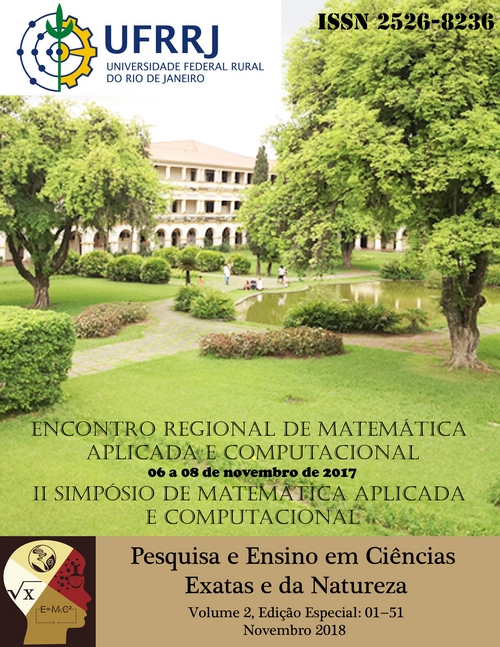Resolução de problemas de elasticidade com carga de domínio pelo Método dos Elementos de Contorno na formulação de dupla reciprocidade
DOI:
https://doi.org/10.29215/pecen.v2i2.1039Resumo
O Método dos Elementos de Contorno transforma equações diferenciais parciais em equações integrais envolvendo somente valores de contorno, após a introdução de funções de ponderação denominadas soluções fundamentais. Quando o problema estudado envolve cargas de domínio deve-se procurar uma solução que preserve a filosofia do método. Para este propósito se utiliza a técnica da Dupla Reciprocidade. Este trabalho ilustra a dupla reciprocidade com a equação de Navier com um termo de peso próprio. Resultados numéricos são apresentados.
Palavras chave: Método dos Elementos de Contorno, Dupla Reciprocidade, Integral de Domínio, Peso Próprio.
Referências
Albuquerque E.L., Sollero P. & Aliabadi M.H. (2004) Dual boundary element method for anisotropic dynamic fracture mechanics. International Journal for Numerical Methods in Engineering, 59(9): 1187–1205. Doi: 10.1002/nme.912
Ang W.T. (2006) A dual-reciprocity boundary element approach for solving axisymmetric heat equation subject to specification of energy. Engineering Analysis with Boundary Elements, 32: 210–215.
Barber J.R. (2010) Body Forces (p. 91–108). In: Barber J.R. (Ed.). Elasticity. Solid Mechanics and Its Applications. Volume 172. Springer: Dordrecht. 534 p.
Bathe K.J. (1996) Finite Element Procedures. New Jersey: Prentice Hall. 1037 p.
Behbahani-nia A. & Kowsary F. (2004) A dual reciprocity BE-based sequential function specification solution method for inverse heat conduction problems. International Journal of Heat and Mass Transfer, 47: 1247–1255. Doi: 10.1016/j.ijheatmasstransfer.2003.09.023
Brebbia C.A., Telles J.C.F. & Wrobel L.C. (2012) Boundary Element Techniques. Berlin: Springer. 464 p.
Burden R.L. & Faires J.D. (2008) Análise Numérica. São Paulo: Cengage do Brasil. 736 p.
Cheng A.H.D., Cheng C.S., Goldberg M.A. & Rashed Y.F. (2001) BEM for thermoelasticity and elasticity with body force – A revisit. Engineering Analysis with Boundary Elements, 25: 377–387. Doi: 10.1016/S0955-7997(01)00032-7
Choi C. Y. (1999) Dual reciprocity boundary element analysis for the laminar forced heat convection problem in concentric annulus. KSME International Journal, 13: 496–503. Doi: 10.1007/BF02947719
Davies T.W. & Moslehy F.A. (1994) Modal analysis of plates using the dual boundary element method. Engineering Analysis with Boundary Elements, 14: 357–362. Doi: 10.1016/0955-7997(94)90066-3
Lanczoz C. (1986) The Variational Principles of Mechanics. Toronto: Dover Publications. 464 p.
Malvern L.E. (1969) Introduction to the Mechanics of a Continuous Medium. New Jersey: Prentice-Hall. 771 p.
Nardini D. & Brebbia C.A. (1982) A new approach to free vibration analysis using boundary elements. Applied Mathematical Modelling, 7: 157–162. Doi: 10.1016/0307-904X(83)90003-3
Niku S.M. & Adey R.A. (1996) Computational aspect of the dual reciprocity method for dynamics. Engineering Analysis with Boundary Elements, 18: 43–61.
Owatsiriwong A. & Park K.H. (2008) A BEM formulation for transient dynamic elastoplastic analysis via particular integrals. International Journal of Solids and Structures, 45: 2561–2582. Doi: 10.1016/j.ijsolstr.2007.12.009
Partridge P.W. & Sensale B. (2000) The method of fundamental solution with dual reciprocity for diffusion and diffusion-convection using subdomains. Engineering Analysis with Boundary Elements, 24: 633–641. Doi: 10.1016/S0955-7997(00)00043-6
Partridge P.W., Brebbia C.A. & Wrobel L.C. (1991) The Dual Reciprocity Boundary Element Method. Berlin: Computational Mechanics Publications. 276 p.
Popov E.P. (1999) Mechanics of Solids. New Jersey: Prentice Hall. 888 p.
Rodríguez C.P. (2012) Método de elementos de contorno de reciprocidad dual aplicado a la termoelasticidad anisótropa desacoplada. Tese de Doutorado, Departamento de Ingeniería Mecánica y de los Materiales, Escuela Técnica Superior de Ingeniería, Universidad de Sevilla, Sevilla.
Sarler B. & Kuhn G. (1998) Dual reciprocity boundary element method for convective-diffusive solid-liquid phase change problems. Part I – Formulation. Engineering Analysis with Boundary Elements, 21: 53–63. Doi: 10.1016/S0955-7997(97)00112-4
Vera-Tudela C.A.R. (2003) Formulações Alternativas do MEC para Problemas Elastodinâmicos de Mecânica da Fratura com o uso da Função de Green Numérica. Tese de Doutorado, COPPE – Universidade Federal do Rio de Janeiro, Rio de Janeiro.
Vera-Tudela C.A.R. & Telles J.C.F. (2005) A numerical Green’s function and dual reciprocity BEM method to solve elastodynamic crack problems. Engineering Analysis with Boundary Elements, 29: 204–209. Doi: 10.1016/j.enganabound.2005.01.004
Downloads
Publicado
Edição
Secção
Licença
Autores que publicam nesta revista concordam com os seguintes termos / Authors who publish in this journal agree to the following terms:
A) Autor(es) e o periódico mantêm os direitos da publicação; os autores concedem ao periódico o direito de primeira publicação, sendo vedada sua reprodução total ou parcial sob qualquer caráter de ineditismo; qualquer utilização subsequente de trechos de manuscritos (e.g., figuras, tabelas, gráficos etc.) publicados na Pesquisa e Ensino em Ciências Exatas e da Natureza deve reconhecer a autoria e publicação original / Author (s) and the journal maintain the rights of publication; the authors grant the journal the right of first publication, being prohibited their total or partial reproduction in any character of novelty; any subsequent use of excerpts from manuscripts (e.g., figures, tables, graphics, etc.) published in Research and Teaching in Exact and Natural Sciences must acknowledge the original authorship and publication.
B) Autores tem o direito de disseminar a própria publicação, podendo, inclusive disponibilizar o PDF final do trabalho em qualquer site institucional ou particular, bem como depositar a impressão da publicação em bibliotecas nacionais e internacionais / Authors have the right to disseminate the publication itself, and may also make available the final PDF of the work in any institutional or private site, as well as depositing the printing of the publication in national and international libraries.


